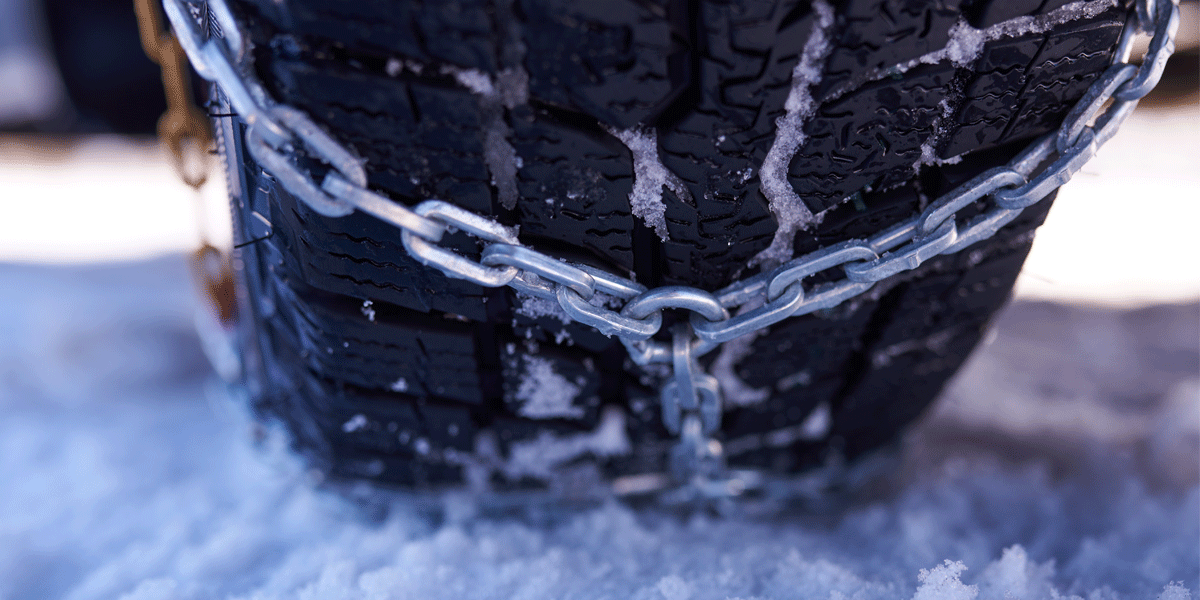Following 19 years as an over-the-road truck driver, and more than 2 million accident-free miles, Jody joined ATS as a safety specialist in 2019. Today, using his well-rounded knowledge of truck driver safety and safe practices, Jody acts as a driver safety counselor overseeing ATS's newest safety program, ATS Safety Driven University. Jody approaches each day in the transportation world with self-confidence and poise as he helps ATS's many drivers improve their safety knowledge and practices.
Revised November 20, 2025
When winter weather moves in, the right equipment — and the confidence to use it — makes all the difference. After 19 years on the road, and more than 2 million accident-free over-the-road (OTR) miles (including through many snow-covered mountain passes), I've seen what winter can throw at a driver. Now, as part of the Anderson Trucking Service (ATS) safety team, I'm here to help drivers chain up correctly, stay compliant, and make confident, safe decisions when winter weather hits (and it will!).
Whether you love them, hate them, or have never touched a set of them before, tire chains are a necessity to staying safe (and legal) on winter roads.
Every state handles tire chain laws a little differently, and every trucking company sets its own rules, too. Some carriers expect drivers to chain up in winter conditions to keep the freight moving. Others, like ATS, put a priority on driver safety, and recommend pulling off and parking somewhere when conditions become too dangerous.
Truck drivers operating in winter conditions across the Rocky Mountain states must understand tire chain laws, safety requirements, and proper chaining techniques to stay compliant and avoid costly fines.
Key Points to Consider with Tire Chains
- They are meant for slow (25-30 mph), short-distance travel on winter roads only
- They can cause significant damage and should be avoided altogether unless absolutely necessary or required
- Tire chain laws vary by state, and most states allow tire chains only when weather requires them
- Knowing how to install tire chains correctly is something every truck driver should know
- Your safety matters more than any delivery
This article explains what tire chains are, how they work, and why truck drivers operating in cold-weather markets (Upper Midwest, Mountain West, Pacific Northwest) should use them cautiously, so let's get into it and make sure you’re prepared for the road ahead.
What Are Tire Chains?
Tire chains are metal traction devices that wrap around your truck's tires to help you keep control on snowy or icy roads. They're meant for short, slow-distance travel only. When tire chains are on, you shouldn't drive faster than 25-30 miles per hour (mph).
Even when installed correctly, driving with tire chains on makes for a rough, uncomfortable ride. If a chain comes loose, it can cause major damage (blown tires, torn equipment, etc.) and other costly issues.
Because tire chains can cause significant damage, the best practice is to avoid using them altogether. Not only that, but even if there are designated areas to chain up, they’re often just narrow shoulders along busy, icy highways, which making chaining up stressful and potentially dangerous as traffic slides by.
Tire Chain Laws by State & Region
As a truck driver, it's important to know the rules of the states you're driving through, and this applies to tire chain laws as well, as tire chain laws are mandated on the state level. The laws spell out when you can, should, or must use tire chains, particularly during winter weather or when going through mountain passes. While many states let drivers use tire chains whenever conditions call for them, others are more limiting, allowing them only during certain months.
Using the wrong type of chain, or chaining up when it's not allowed, can subject you to fines. And nobody likes fines. Plus, along with the risk of damaging your truck or trailer, tire chains can damage roads, too, which is why states regulate how and when they can be used.
Check this quick reference guide to know the when, where, and how of tire chain laws by state and region:
Midwest
- Missouri: Chains allowed when required due to poor weather (not permitted from Apr. 1-Nov. 1)
- North Dakota: Studded tires allowed from Oct. 15-Apr. 15. Chains allowed as needed for poor weather
- Ohio: Studded tires allowed from Nov. 1-Apr. 15
Northeast
- Connecticut: Chains and studded tires (winter tires w/ small spikes embedded in the tread) permitted from Nov. 15-Apr. 30
- Delaware: Chains allowed from Oct. 15-Apr. 15
- Maryland: Chains required during declared snow emergencies. Not allowed on vehicles > 10,000 lbs.
- Massachusetts: Chains permitted from Nov. 1-May 1
- New York: Allowed when a state/local snow emergency is declared
- Pennsylvania: Chains allowed from Nov. 1-Apr. 15
Southeast
- Florida: No tire chain laws
- Georgia: Chains required when posted
- Kentucky: Chains allowed only on ice-covered roads, but with limits on tire size/spacing
- West Virginia: Chains allowed Nov. 1-Apr.15
West
- Alaska: Rules vary by region & season. Always check local notices
- California: Mountain chain regulations include:
- Level 1: Chains on all vehicles, except passenger/light trucks <6,000 lbs. w/ snow tires
- Level 2: Chains required except on 4WD/AWD with snow-tread tires
- Level 3: Chains on all vehicles with no exceptions
- Colorado: Drivers must carry chains from Sept. 1-May 31 in certain areas. Use chains when posted
- Hawaii: No tire chain laws (shocker!)
- Idaho: Studded tired permitted from Oct. 1-Apr. 30. Chains allowed as needed and required on certain mountain passes
- Montana: Chains may be required year-round when chain-up signs are posted
- Nevada: Chains required for vehicles over 10,000 lbs. when posted
- Oregon: Chains allowed from Nov. 1-Mar. 31
- Utah: Chains allowed when posted or road conditions require
- Washington: Chains required on certain routes from Nov. 1-Apr. 1
Etc.
- AL, AZ, AR, IL, IN, IA, KS, LA, ME, MI, MN, MS, NE, NH, NJ, NM, NC, OK, RI, SC, TN, TX, VT, VA, WI, WY: Chains allowed when required due to snow, rain, or poor weather
Disclaimer: This article provides a general overview of tire chain laws in the U.S. Always consult official state transportation department websites for the most up-to-date and specific information.
Are There Different Types of Tire Chains Truck Drivers Use?
Yes! When winter roads get slick, it's good to have options. Luckily, there are a few different types of chains and tools drivers can use to stay in control. Let's get into them.
- Single and Dual Chains: These are the most commonly used by over-the-road (OTR) truck drivers. Must be manually — and carefully — put on, usually in cold, snowy conditions on the side of the road. What's the difference? Well, it's pretty simple:
- Single chains: Fit over one tire
- Dual chains: Cover a (get this!) dual-wheel set. They're heavier and take longer to install, but they have the strongest grip on icy mountain passes
- Cables: Similar to chains, but lighter, cheaper, and easier to handle, which means they can break much more easily. Generally, they're just used by truck drivers as a one-time backup option
- Tire/Snow Socks: Pretty much what it sounds like — a "sock" of woven fabric that slides over the tire tread to give more traction. They work well, and are simple to put on, but they're expensive, and not every state accepts them in lieu of chains.
- Studded Tires: Small metal spikes, or studs, are embedded into the tire tread to help grip snow and ice, but many states restrict or ban them.
What is the Tire Chain Policy for Drivers at ATS?
At Anderson Trucking Service, your safety always comes first. That's why we do not require our drivers to use tire chains. If road conditions get bad enough that chains are needed, we want you off the road and parked someplace safe, rather than trying to push through dangerous weather. It boils down to this:
No load is worth risking your life.
If you feel uncomfortable with the weather conditions, we encourage you to let your driver manager know and park until things improve.

Last Stop: Stay Safe on Winter Roads
Let's face it: winter's coming. Every truck driver needs to be prepared for changing weather conditions (plan ahead!) and the different tire chain laws you'll encounter across the United States. Even if your carrier company doesn't require tire chains, learning how to install them correctly is something every driver should know. It can save valuable time and help keep you and everyone around you safe.
Stay informed and be prepared with whatever winter throws at you with these winter driving tips and stay safe out there.


